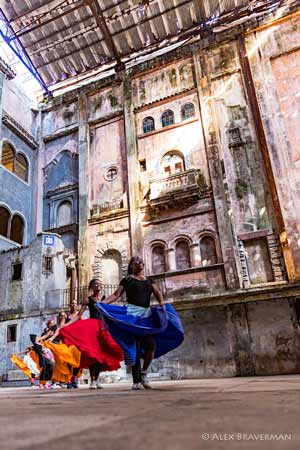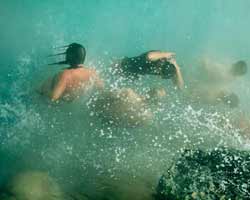Student Success: Student Success: Alex Braverman

After working as a self-proclaimed ‘computer geek’ for most of his life, Alex Braverman realized his untapped eye for photography. After receiving a digital camera as a New Year’s gift from his wife, he’s gone on to win countless worldwide photography competitions, including the 2015 B&W Magazine Portfolio Award for Dance Photography. We recently caught up with Alex to chat about the industry, his time at NYIP, and his eccentrically refreshing outlook on creativity.
1. What career field were you working in before you decided to study photography on a more professional level?
I was a computer geek all my life, but had no involvement in photography at all!
2. When did you make the shift to study photography instead? What made you realize your passion for taking photos?
The INS prohibited me from working for a couple of years until my residence status in the USA was sorted out- but I’m a hyperactive person and cannot be idle.
So for the New Year in 2004, I got a present from my wife: the just released Canon Digital Rebel. There was no turning back. The very first photo I submitted to a regional contest won the Best in Show!
3. When did you enroll at NYIP?
Around 2006 I caught myself thinking that I knew everything about photography. I was already published in Popular Photography magazine, I had sold an ad to Ford, and I had produced some innovative work for a dance company (Bruce Wood Dance Company in Fort Worth, TX – I virtually slept in their studio for 6 months).
At my age, in my 50’s, when one thinks he knows everything – it is the best time to actually start studying it! NYIP came up while I was investigating some MFA possibilities, and I chose to start with the basics.
4. What was your coursework like?
The lighting aspects were enlightening. I remember, to this day, the comment made by my mentor: “Quit looking at the photos of others, go to an art gallery and take a look at the paintings by Vermeer – then you will know everything there is to know about lighting.” This was one of the most enlightening moments in my study, then and now.
Some of the compositional ideas and the basic principles were very useful. I’d call them “suggestions” rather than “rules.” Art has no rules, for instance, most of Cartier-Bresson portraits blatantly violate the “rule of the thirds.”
Some of the photo assignments were challenging and require a lot of thinking before the first shot is actually fired. I liked that a lot! One of my assignments in composition was actually purchased by NYIP, and I was issued a Merit Certificate.
5. Was your mentor helpful during the process?
He was instrumental in everything. He provided the content to the information, forever pushing me to the new level of vision and technique. Kudos!
6. When you realized you wanted to start working professionally, how did you initially get your foot in the door?
I didn’t! I’m still working on it. Frankly, I desperately need a business manager that would turn my work into a sellable product. Meanwhile, I simply do what I love, and sometimes people give me money for it. This is my general attitude to the professional side.
We had a lot of fun on some photography forums deciding what makes one a professional photographer. I think you are a professional photographer if you order an under-exposed steak at a restaurant. Or a glossy donut!
I don’t do weddings, but I am the one and only divorce photographer in the world! And I have some shots I choreographed with the State Ballet of Norway to prove it!
7. We can see on your website that you’ve repeatedly earned awards from worldwide photography competitions. When did you decide to start entering your work?
I started submitting my work right away, even before NYIP. Sometimes my arrogance has no bounds! And I do need this arrogance in photography, because the truth is, I’m still rather insecure about the quality of my work.
Even after winning the Grand Prize in the 15th Annual Readers Contest of Popular Photography Magazine 2009, I still thought it was a lucky fluke. But, as said the great golfer Gary Player, “the more I practice, the luckier I get.” I gained some confidence in my work when B&W magazine (which I consider the best photo publication there is) started publishing just about everything I submitted to them. With this, my self-criticism has reached new heights. I took about 150,000 photographs in the last 12 years, I processed about 2-3,000, and I genuinely like about 50 of them. All these are award winning photos, some of them are published, some were exhibited in the galleries in NYC, Colorado, Texas, Argentina, and I don’t even know where else.
And yet, I still consider myself a beginner. I teach sometimes (mostly PPA Super Mondays), but end up learning more from my students than they learn from me. My rare and far apart students are typically seasoned photographers (including the ex-president of PPA Robert Lloyd) who find my work interesting enough to walk the streets with me, and change their vision. My courses are never called “Studio lighting” or “Wedding basics,” but rather “Breaking the bounds” or “Zen and the art of photography.” They are aimed at those who know more about the technique than I ever will.
8. When you read competition’s prompt and guidelines, how do you usually begin? How do you find inspiration?
In my rather short artist’s statement: Photography is about what does not meet the eye.
9. Will you enter more photo competitions in the future? Have any in mind?
My ambition is to win Lucie! I’m working on it. This year I submitted a number of portfolios to IPA for the first time and received an Honorable Mention. I can live with that for a year or two. But I do need to raise the bar or sell my cameras!
10. This year’s Pollux Awards earned you a 2016 exhibition in Madrid- how are you preparing for that?
The selection is essentially made by WPGA who manage Pollux Awards. I know what I’ll exhibit, and so do they.
11. Tell us about your recent trip to Cuba.
This was a cultural exchange program organized by Santa Fe Workshops. I met some incredible Cuban photographers, and I sincerely hope that NYIP would consider bringing them over for a weeklong workshop and collaboration – it’s the thing to do!
I was born in the USSR, and since nothing really changed in Cuba since the revolution, it was like time travel for me, going back to the environment of my childhood. I was quite overwhelmed by the experience.
The workshop was dedicated to dance, which is my poison of choice, so the artistic field was wide open. We got two private sessions with dancers from the National Ballet of Cuba, indoors and outdoors. We had a chance to work with Flamenco Ecos – a Cuban household name, and some other great dancers.
The strangest thing was that with the exception of the National Ballet, these dance companies have no studios or theaters of their own. Two major shoots were done amidst the ruins of old theaters, and one in the ruined bathhouse. Very cool photo-op, but less cool for them. The photo I’ve attached to this feature shows Raices Profundas at the ruined Lido Theatre. It’s got a lot of content, and is probably a good example of various compositional “rules.”
The first two galleries of Cuban dance are already up on my website.
12. What value do you think these exhibitions and workshops bring to the world of photography?
Every human endeavor belongs to either science or art. Science describes the external world; art aims at an emotional impact. We have an inherent ability to understand life through this emotional impact – and work of an artist is to deliver just that. It would be absurd to study Renoir with a spectroscope; one would learn nothing of value. But I make my monthly pilgrimage to the Art Institute of Chicago to converse with some paintings, and to discover what they are really about.
So what’s the value of exhibitions and workshops? The emotional impact they generate, or they would be quite pointless.
13. What qualities do you think a successful, aspiring photographer needs?
Fearless honesty and self-knowledge.
Every photograph is a self-portrait. Had you known that, would you be taking the same pictures?
The very first question I ask while reviewing peers’ work is: why did you take this picture? I don’t care whether it is technically “good” or “bad.” I want to know why this one? What grabbed you? You could have taken a thousand photos from this very spot at exactly the same time – so why this?
I think an aspiring photographer should ask himself this question as often as possible. One gets to the entire new paradigm of art while trying to answer it.
14. In browsing your portfolio, we can see that it’s separated into 8 different categories- do you have a personal favorite?
Dance or bust! My artist’s statement specifically for dance photography is: Dance is the art of motion – and so is photography.
15. What do you always carry with you in your camera bag, anything special?
My passion!
16. What’s the most interesting thing you learned at NYIP?
Anyone can learn the technique, but being an artist is a different form of existence.
17. If you had to pick one, what was the most memorable photography project you’ve ever completed?
Birds of Prey, photographed at Lois Greenfield studio November 2, 2014. Enjoy!
18. Describe a typical day in your life as a professional photographer.
I don’t have typical days. On some days I shoot, on others I process. And there are plenty of days when I simply feel uninspired, which is another way of saying – being lazy.
19. What’s the most rewarding part of studying photography, and mastering it as a lifelong career?
That new form of existence. My eyesight is getting a little fickle with age, and yet I see the world so much better! And I see myself so much better, too.
20. If you could give one piece of advice to our current and prospective students, what would it be?
Learn everything without cutting corners, shoot and process until little drops of blood appear on your forehead – and then forget all of it as quickly as you can. Only YOU can take this photograph, only YOU know its worth.




